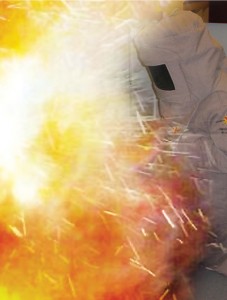 Many of us have been raised to believe that respect is not given, it is earned — the question you have to ask yourself is whether or not you want Electricity to earn your respect. The individuals speaking through this article illustrate why, in the case of Electricity, the respect rule that you may have been taught and live by needs an exception — that exception is Electricity. A large amount of energy reached out and touched the two individuals who are about to tell you their stories. One of them was prepared, but the other was not, for what they were about to experience. Both of these events occurred well before arc flash graced the pages of NFPA 70E. These two individuals experienced an arc-flash event and lived to tell about it. The event changed both of their lives, but in different ways. Listen to their stories and again ask yourself if Electricity deserves your respect.
Many of us have been raised to believe that respect is not given, it is earned — the question you have to ask yourself is whether or not you want Electricity to earn your respect. The individuals speaking through this article illustrate why, in the case of Electricity, the respect rule that you may have been taught and live by needs an exception — that exception is Electricity. A large amount of energy reached out and touched the two individuals who are about to tell you their stories. One of them was prepared, but the other was not, for what they were about to experience. Both of these events occurred well before arc flash graced the pages of NFPA 70E. These two individuals experienced an arc-flash event and lived to tell about it. The event changed both of their lives, but in different ways. Listen to their stories and again ask yourself if Electricity deserves your respect.
“I wasn’t wearing my safety gear.”
Donnie Johnson is a guy just like you and me – except for the scars from an arc-flash event that occurred on Thursday, August 12, 2004. That Thursday changed Donnie’s life forever. Living in The Sunshine State is tough for a person who now has to cover his exposed skin because he can’t take the sun’s rays for any more than an hour or so. Going to the beach and other outdoor activities for a guy who used to walk around in shorts and flip flops is something of the past.
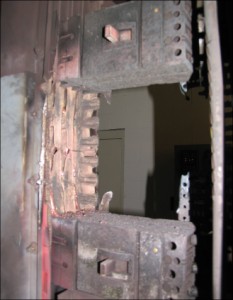
Photo 1. This is what is left of the equipment on which Donnie Johnson was working.
Donnie met the equivalent of the sun up-close and personal on that Thursday when his phase rotation meter failed. He was not wearing his personal protection equipment (PPE), and he was scarred for life. You see, arc terminals can reach or exceed 35,000 degrees Fahrenheit (F) — four times the temperature of the sun’s surface. Arc-flash research has revealed that a person who is exposed to an arc-flash event can have temperatures upwards of 437°F at their hands, 122°F at the chest area and upwards of 437°F at the face. Donnie was lucky that day and is quite fortunate to be able to tell his story. He welcomed the opportunity to share his mistakes and how this event changed his life in hopes that someone who hears his story will make a change and do what’s right when it comes to electrical safety.
When did you get into the trade?
“I had an uncle who was an electrician. I grew up in a funeral home with my grandfather and he convinced me to go to college to be a mortician. Another one of my uncles said you need to learn a trade to fall back on. Well, twenty-eight years later here I am trying to learn a trade to fall back on. I like the challenging aspects of electrical work. I never was an electrical appliance and wire guy . . . I like the challenge of electrical work and trying to figure things out.”
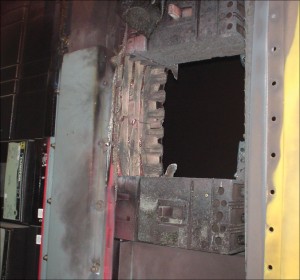
Photo 2. A close-up of the damaged bus work. Donnie was very lucky to have escaped the flying debris and molten metal that obviously became airborne during this event.
You see, Donnie is the kind of guy that loves to troubleshoot and to answer customer questions. This desire has helped him expand his experience in the trade and gives him flexibility that has helped him adjust to his life-changing event.
“I’ve done residential, commercial, industrial, and high-voltage work. I can operate any crane, line truck or other trucks; any of that stuff. So I think I’m a lot better well-rounded than many. You know, I don’t want to get stuck in one aspect of the trade.”
Donnie is into computers as well. Anyone who enjoys troubleshooting and figuring out the complex usually does quite well with computers.
So what do you do in your spare time?
“I work with my hands. I’m always tinkering with something out in the shed. My latest project, my son and I are building a guitar from scratch. He likes the guitar and we’re building it together from scratch. I got a block of wood and we rounded out some channels in it. We’re cutting out the shape now.”
At one point, Donnie told his wife that as long as he had his hands, he would be able to provide for his family. But today, Donnie’s hands aren’t what they used to be.
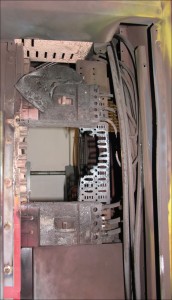
Photo 3. This image helps to convey the magnitude of heat and destruction involved in the arc-flash events. You can see where a chunk of metal is missing due to the heat that was generated. The missing copper condctor that melted. These metals added to the arc-flash event.
“. . . I can’t feel anything from my fingertips back. I have my palms, they are still good; but wherever there is grafting I can’t feel anything. Another way of explaining it, if you ever wore dishwashing gloves which feel tight, well it feels like that all the time. I can feel pressure… sort of like when at the dentist and they give you that shot. I can feel pressure but can’t feel natural sensations. On just a very few spots, I’m hypersensitive. For example, when you put your hands in your pants pocket and you scrape across one of those little areas it feels like I’m getting shocked. Twenty-five percent of my body is burned — third degree. That’s basically from where your short sleeves stop on like a golf shirt down. I’m burned all the way down to the muscle. My hands . . . well you know boiled chicken? When you pull it out of the water how the meat is just falling off the bone? That’s kind of like what my hands looked like. They were charred black. They [the doctors] mashed what was there back into a hand shape and then stapled some skin over them. That’s why [the severe burn] the nerve endings are gone. Those areas where I feel like I’m getting shocked are where nerve endings are close to the top. On the back of my hand . . . you know how you can move the skin around on the back of your hand, if you use your finger? Well I can’t do that with my hand. It’s fixed to what is underneath. That’s part of the tightness I feel. It’s supposed to slide around like it is two different layers but it doesn’t.”
The condition of Donnie’s skin makes doing many things around the house difficult. Special precautions have to be taken as having no feeling with skin that is very thin creates other problems. As an example Donnie explained:
“I was working on the sprinklers and I was working on the manifold on the wall. I have a stucco wall. I looked at the wall and I could see blood all over it. I had rubbed my hand against the stucco and it rubbed off my skin and I didn’t know it. I don’t have any feeling so I didn’t feel it. I looked at the back of my hand and it was completely skinless. So I wear gloves a lot.”
What about safety?
Donnie grew up in the trade when safety didn’t have as much of a focus. It’s come a long way over time, but years ago he got away with wearing short pants and work boots while working.
“You worked on stuff hot all the time and you didn’t even think about it. When I was starting out there was nothing about protection.”
Over the years Donnie sat through classes, but he was the type of guy who really didn’t pay attention. He thought that the training was a way for the corporation to prevent lawsuits. He never realized the things that he was being taught could come in good use one day.
“I never heard arc flash until I got with the company I’m with now. It didn’t mean anything to me. If you would have asked me twenty years ago what an arc flash is I wouldn’t know. I don’t even think today that smaller outfits have as much training as larger outfits . . . I had training but if I would have listened it would have saved me.”
“Today we won’t go into anything hot if it can be shut off. Shutting it off is the first choice. You have to have a good reason why you can’t shut it off. You can’t take chances and my guys know this. I look back on all the stupid stuff I’ve done when I was younger. I’ve been in the back of switchgear crawling around. Safety now has taken a big leap. Today we have a safety plan and we have safety meetings. Our clientele demand it as well. You have to meet their safety criteria as well as your own. In recent years safety is becoming more popular and having your safety plan is more popular and a part of doing business. People are paying more attention to it. One of the first things I said when I stumbled out of that room that day, I said, ‘This can’t be happening to me.’”
So how did the arc flash occur?
“I was literally 3 seconds from being done with that job. All I was doing was getting the rotation reading. I’m not making any excuses or anything, but the meter I used was a motor rotation meter and that’s just for when you spin the shaft to get the rotation of the motor. You are not supposed to use that on live circuits. I had another combination phase rotation and motor rotation meter on the truck too. They are both little yellow boxes with wires hanging out of them. I can’t say that I was in a hurry, wasn’t paying attention, or maybe showing off but I probably picked up the wrong one at the time. You know that motor rotation meter that I was using, I had actually used it on live circuits before and had been using it for three or four months until this point. It worked on the generator power. But when I put it on the equipment, that’s when it failed. I already had the readings from the generator; I had to just get the readings from the building. When you hook up a generator that is the final thing — you check for phase rotation and you’re done. This was a 480-volt system . . . the upstream breaker was 3000 amps.”
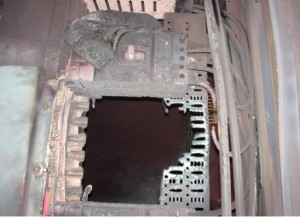
Photo 4. After an event such as this, down time can be very extensive. There are many options on the market that can reduce the energy and, in fact, the National Electrical Code introduced a requirement for arc reduction technologies in Section 240.87 of NEC-2011.
Did you know whatthe energy levels were?
“No, this is before the arc-flash stickers were mandated. I knew it was 480 volts. I knew that this voltage would flash before 120 volts will. It will arc a lot faster too. ”
So what happened to get this arc-flash?
“I was using insulated alligator clips. These are the types that look like an accordion. These alligator clips are big, about as big as your thumb. The bus in the panelboard was sandwiched together. Almost like a bus duct. So I put the clip on A-phase and then on B-phase and when I went to clip C-phase, it happened. Now nobody knows for sure whether it was just the meter failing — when it failed, it blew a puff of carbon — or whether one of the leads fell off and it caused the meter to fail. It could have been either one of those; but when that carbon blows in there, it is like taking a cup of water and throwing it in there. An arc itself is conductive. The photos are the actual switchgear. Those were taken by my guys when they were trying to get power back to the warehouse.”
So what do you remember about the blast?
“When that thing went off, it was like being in the ocean: if you stand there and let a big wave just hit you. If you have ever been around a 4 or 5 foot wave, where it just hits you and you feel that wave pushing you and you feel the power of it. That’s what it felt like. It wasn’t just one point of pressure; it was like a wall of pressure slamming me against the wall behind me.”
Donnie did not break any bones or experience any of the flying debris that could have met up with him. He also didn’t inhale the gases that could have burned his lungs.
“I thought that when it happened that it knocked me down and I jumped right back up. Evidently, I was out for like a minute or two. When I first got up it was pitch black and I could see slag all over. I could make out the daylight from around the door, and I just started heading that way.”
Donnie didn’t know how hurt he was and wouldn’t know until much later. He gives a lot of details on his website (www.donniesaccident.com) about what he experienced and what his wife documented after this event.
Recovering from an arc-flash event
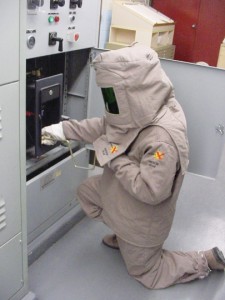
Photo 5. Your first choice should always be to work de-energized. If you must work energized, wear your approved personal protective equipment (PPE). This person is prepared should a problem occur.
Donnie’s sense of humor really shows through, even though he has had such a tragic event. When I asked him about how his hands healed after an injury like that described above, his response was, “It heals . . and, well, it’s not like it’s going to leave a scar, right?”
He says you have to have a sense of humor after something like this. “You can really get down and depressed if you don’t.”
Arc-flash events leave emotional scars in addition to physical scars. Each individual has to go through a physical healing process, but you can’t see the emotional healing that also has to occur. Donnie deals with it through humor — a man after my own heart. You see, Donnie will tell you that he has always been an optimistic person and that is a very important aspect of healing. But even Donnie had those “down” days, and he shared one example with me.
“I was still under the doctor’s care and, well, you can’t do anything, so I was just sitting down in the recliner in the house, bored; and I was starting to get a little down on myself. I was depressed a little bit and my son came down — he was about 10 or 11 at the time — he saw me sitting there depressed and down looking and he took a long look at me . . . he was standing there . . . and he said, ‘What’s up, Crispy?’ I just started laughing. You see no one on the entire planet could get away with saying something like that to me, but he knows me well enough to know I would think that was funny.”
The way Donnie looks at it, he “got a do-over.” He faced death and he won, and he has a chance that others didn’t get. He pointed out numerous times during the interview that he feels lucky. He feels lucky because there are many individuals that never survive this type of event. He is also lucky because his employer stuck by him every step of the way. Those he worked with stepped up and helped his family too. This was very important because at the time that this happened, a hurricane was approaching. His employer and those he worked with did everything they could to help his family during this ordeal.
It was Donnie’s wife that had the idea one day that lead to the creation of a video and a web site to share his story. Donnie told me that if he can save one life, get one guy to wear his PPE, it is all worth it. Donnie’s web site can be found at www.donniesaccident.com. His story is one that should be sobering to all of us who work in and around electricity.
Donnie works in the office today. Working with the same guys he worked with when in the field. He had never worked in an office before. This event changed his career — a man born to work in the field, he misses it.
“My PPE Saved My Life”
Jonathan Cadd made a mistake on the job too, but his story is much different — you see Jonathan took the few minutes that it takes to put on his PPE and when hit with the heat, flames and gasses, he was prepared.
“The facility was a warehouse that was converted to cold storage. It was a NEMA 3R service. The building was old; the service was rusted out and was having problems: intermittent power outages and things like that, nuisance tripping. So I get called out to troubleshoot the service, 800-A 120/208. There were a lot of motor loads for the cold storage and all that. Back then, we didn’t think about arc flash; we knew about it, but we were young and you don’t think of things like that. You’re bulletproof. But, I went inside; took a look at it and I thought to myself, ‘You know this old rusted service, if I exercise this switch — it’s probably never been exercised — what’s going to happen?’ So I thought; well, I had some PPE in the front seat of my truck, went out and put it on. Nothing serious, 10 Calorie suit with full mask, gloves. That was before arc rating and all that type of stuff.”
Jonathan didn’t know how much energy was available at the main that he was going to shut off, but he knew that the PPE he was putting on was better than nothing.
“So I go back in, I have my tester, of course it is live. No one knew where it was being fed from. So I thought I’d see if I could exercise the switch. I thought I was going to de-energize the thing. So I thought. I start to open the switch. I get about halfway and it is stuck. I thought, ‘Well it just hasn’t been exercised in a long time and it’s probably just old and it’s gonna take a little bit more umph to knock this thing out.’ So being twenty and strong and all that type of stuff, I go cranking on this thing and I got it about ¾ of the way. See, it felt like a normal switch, like it was going to de-energize and the whole nine yards; and then it started to feel a little weird.
“I got just past ¾ of the way and I heard a click and felt something come apart in the switch; and before I could do anything, I remember thinking, ‘Oh no!’ Then the arc flash occurred. I remember a blue light, very bright. I was out for a couple of seconds. A couple of guys come running over to help. You see, I was working by myself.
“These warehouse workers came over. I was about 85 feet from the service. The service was on fire. They pulled off my mask and everything. I could see out of the corners of my eyes, not straight ahead. My hood was a face shield with dark glass like a welder’s hood. I think that’s what saved my eyes. I broke a few ribs. My boots were on fire. Had it not been for a little bit of foresight, it could have been worse.”
Why did you put on your PPE?
“To this day, I’m thankful. Thank goodness I didn’t inhale any gases because I had my mask on. As comfortable as I was, I always had the thought [of safety] in the back of my mind. You see, my wife was dating a guy before we got married. He was up on a roof and was electrocuted. He wasn’t an electrician; he was putting up a rain gutter. It burned him up. It was so bad that the electricity blew out the side of his hip. My wife told me his story. I remember how traumatic it was for my wife and I said I’d never put her through that.”
Safety was a part of Jonathan’s life — from his mother who always bought the insurance before boarding a plane to how he himself was always suiting up to race. You see, Jonathan took a lot of risks himself through his hobbies.
“I used to café race at the old Ontario speedway; I had an RD 400. I’d go out and race and, guess what, I had full leathers with steel plates and boots and the whole nine yards. I would never think about getting on that bike without full gear. Never! Safety gear was a part of my regimen.”
Because Jonathan wore his protective equipment, after his event, a trip to the hospital, a quick check, a wrapping of his ribs, he was home. He was out of commission for about one and half months. He still has light sensitivity with his eyes. He had to wear dark glasses and use eye drops for a while after the event. He couldn’t go outside in the sun without protection of his eyes for some time.
Jonathan “was handed the safety baton that day and that torch will never go out.” He does a lot of safety training for IAEI and pours his passion into every session.
Parting thoughts
After asking Donnie what his message to those who read this article would be, he responded with: “This can happen to you . . . No matter what trade you are in, there are safety rules that you need to follow. I don’t know everything there is to know about safety and 70E, but I’m here to tell you what can happen if you don’t follow your safety rules . . . this goes for janitors, masons, and anyone. You should know what your safety rules are. I’m just here to tell you what can happen if you don’t.”
Jonathan’s message is very similar to Donnie’s. “For anyone who reads this article and doesn’t understand what this discussion is all about go to [safety] training. Remember to keep your PPE in the truck and use it. There are so many tools out there today; there are downloadable applications and training opportunities. Your life is worth it. Take the 5 minutes to put your PPE on. There is no reason for anyone to get hurt. We have the technology today.”
As always, keep safety at the top of your list and ensure that you and those around you live to see another day. If you have any tips or ideas you would like to share, please feel free to send them to me atthomasadomitrovich@eaton.com. I look forward to your input to these articles and guidance for future articles.












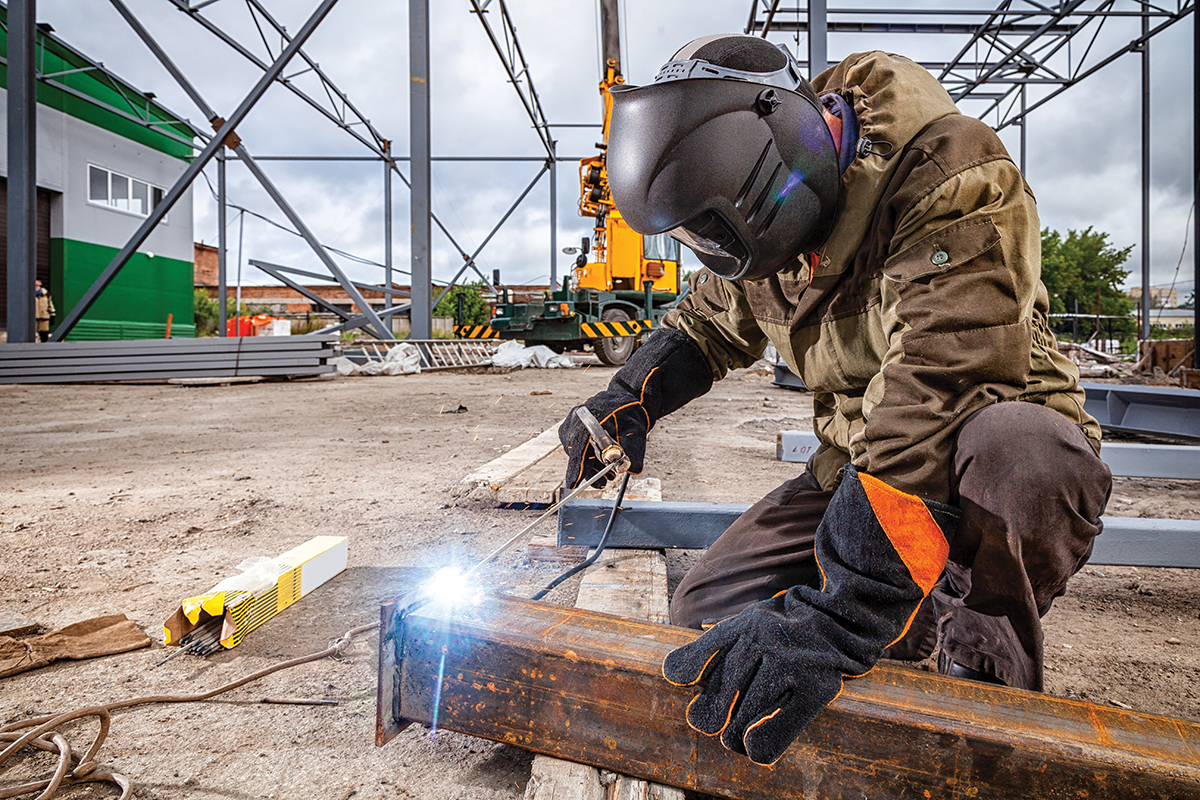

Find Us on Socials